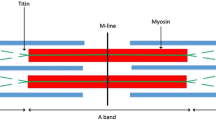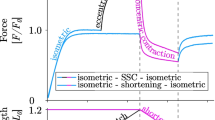Summary
Reciprocal Ia inhibition from ankle flexors to extensors was studied during voluntary tonic isometric dorsiflexion and plantar flexion in five normal subjects. The Ia inhibition was examined as the short-latency suppression of the soleus H-reflexes by stimulation of the low-threshold afferents in the common peroneal nerve (Mizuno et al. 1971). At rest, weak Ia inhibition was demonstrated in four subjects out of five, the maximal amount being 14.1 ± 5.0% suppression of the control H-reflex. The absolute amount of inhibition, which was calculated by subtracting the mean size of the conditioned H-reflex from that of the control H-reflex and expressed as a percentage of the maximal M-response, increased during ankle dorsiflexion, and decreased or disappeared during plantar flexion in parallel with the amount of contraction. The neural mechanisms for facilitation of the Ia inhibitory pathway during dorsiflexion were considered to support the hypothesis of “α-γ-linkage in reciprocal inhibition”, i.e. combined facilitatory effects on the Ia inhibitory interneurone from the supraspinal centers directly and indirectly via the γ motoneurone — Ia afferent route. The mechanism for inhibition of the pathway during plantar flexion was considered to be inhibition of the Ia interneurone of the flexor side by Ia interneurone of antagonist extensors. A quantitative aspect of activity in the reciprocal Ia inhibitory pathway on the performance of voluntary movement is revealed in this study.
Similar content being viewed by others
References
Baldissera F, Hultborn H, Illert M (1981) Integration in spinal neuronal systems. In: Brooks V (ed) Handbook of physiology, Section I: Nervous system II. American Physiological Society, Bethesda, pp 509–595
Creed RS, Denny-Brown D, Eccles JC, Liddel EGT, Sherrington CS (1932) Reflex activity of the spinal cord. Reprinted with annotations by Lloyd DPC (1972) Oxford University Press, London, pp 148–151
Desmedt JE (1973) A discussion of the methodology of the triceps surae T- and H-reflexes. In: Desmedt JE (ed) New developments in electromyography and clinical neurophysiology, vol 3. Karger, Basel, pp 773–780
Eccles JC (1969) The inhibitory pathway of the central nervous system. Liverpool University Press, Liverpool
Hongo T, Jankowska E, Lundberg A (1969) The rubrospinal tract. II. Facilitation of interneuronal transmission in reflex paths to motoneurones. Exp Brain Res 7: 365–391
Hultborn H, Jankowska E, Lindstrom S (1971) Recurrent inhibition from axon collaterals of transmission in the Ia inhibitory pathway to motoneurones. J Physiol (Lond) 215: 591–612
Hultborn H (1972) Convergence on interneurones in the reciprocal Ia inhibitory pathway to motoneurones. Acta Physiol Scand [Suppl] 375: 1–42
Hultborn H, Pierrot-Deseilligny E (1979) Changes in recurrent inhibition during voluntary soleus contractions in man-studied by an H-reflex technique. J Physiol (Lond) 297: 229–251
Jankowska E, Tanaka R (1974) Neuronal mechanism of the disynaptic inhibition evoked in primate spinal motoneurones from the corticospinal tract. Brain Res 75: 163–166
Jankowska E, Padel Y, Tanaka R (1976) Disynaptic inhibition of spinal motoneurones from the motor cortex in the monkey. J Physiol (Lond) 258: 467–487
Kuno M (1959) Excitability following antidromic activation in spinal motoneurones supplying red muscles. J Physiol (Lond) 149: 374–393
Lundberg A (1970) The excitatory control of the Ia inhibitory pathway. In: Anderson P, Jansen JKS (eds) Excitatory synaptic mechanisms. Universitetsforlaget, Oslo, pp 333–340
Mizuno Y, Tanaka R, Yanagisawa N (1971) Reciprocal group I inhibition of triceps surae motoneurones in man. J Neurophysiol 34: 1010–1017
Simoyama M, Tanaka R (1974) Reciprical Ia inhibition at the onset of voluntary movements in man. Brain Res 82: 334–337
Tanaka R (1974) Reciprocal Ia inhibition during voluntary movements in man. Exp Brain Res 21: 529–540
Tanaka R (1976) Reciprocal Ia inhibition and voluntary movements in man. In: Homma S (ed) Understanding of the stretch reflex. Elsevier, Amsterdam Oxford New York (Prog Brain Res, vol 44, pp 291–302)
Tanaka R (1980) Inhibitory mechanism in reciprocal innervation in voluntary movements. In: Desmedt JE (ed) Spinal and supraspinal mechanisms of voluntary motor control and locomotion. Karger, Basel (Prog Clin Neurophysiol, vol 8, pp 117–128)
Vallbo AB (1970) Discharge patterns in human muscle spindle afferents during isometric voluntary contractions. Acta Physiol Scand 80: 552–566
Vallbo AB (1974) Human muscle spindle discharge during isometric voluntary contractions. Amplitude relations between spindle frequency and torque. Acta Physiol Scand 90: 319–336
Yanagisawa N, Tanaka R, Ito Z (1976) Reciprocal Ia inhibition in spastic hemiplegia of man. Brain 99: 555–574
Yanagisawa N, Tanaka R (1978) Reciprocal Ia inhibition in spastic paralysis in man. In: Cobb WA, Duijn H (eds) Contemporary clinical neurophysiology. Elsevier, Amsterdam (EEG Suppl, No 34, pp 521–526)
Yanagisawa N (1980) Reciprocal reflex connections in motor disorders in man. In: Desmedt JE (ed) Spinal and supraspinal mechanisms of voluntary motor control and locomotion. Karger, Basel (Prog Clin Neurophysiol, vol 8, pp 129–141)
Author information
Authors and Affiliations
Rights and permissions
About this article
Cite this article
Shindo, M., Harayama, H., Kondo, K. et al. Changes in reciprocal ia inhibition during voluntary contraction in man. Exp Brain Res 53, 400–408 (1984). https://doi.org/10.1007/BF00238170
Received:
Issue Date:
DOI: https://doi.org/10.1007/BF00238170




